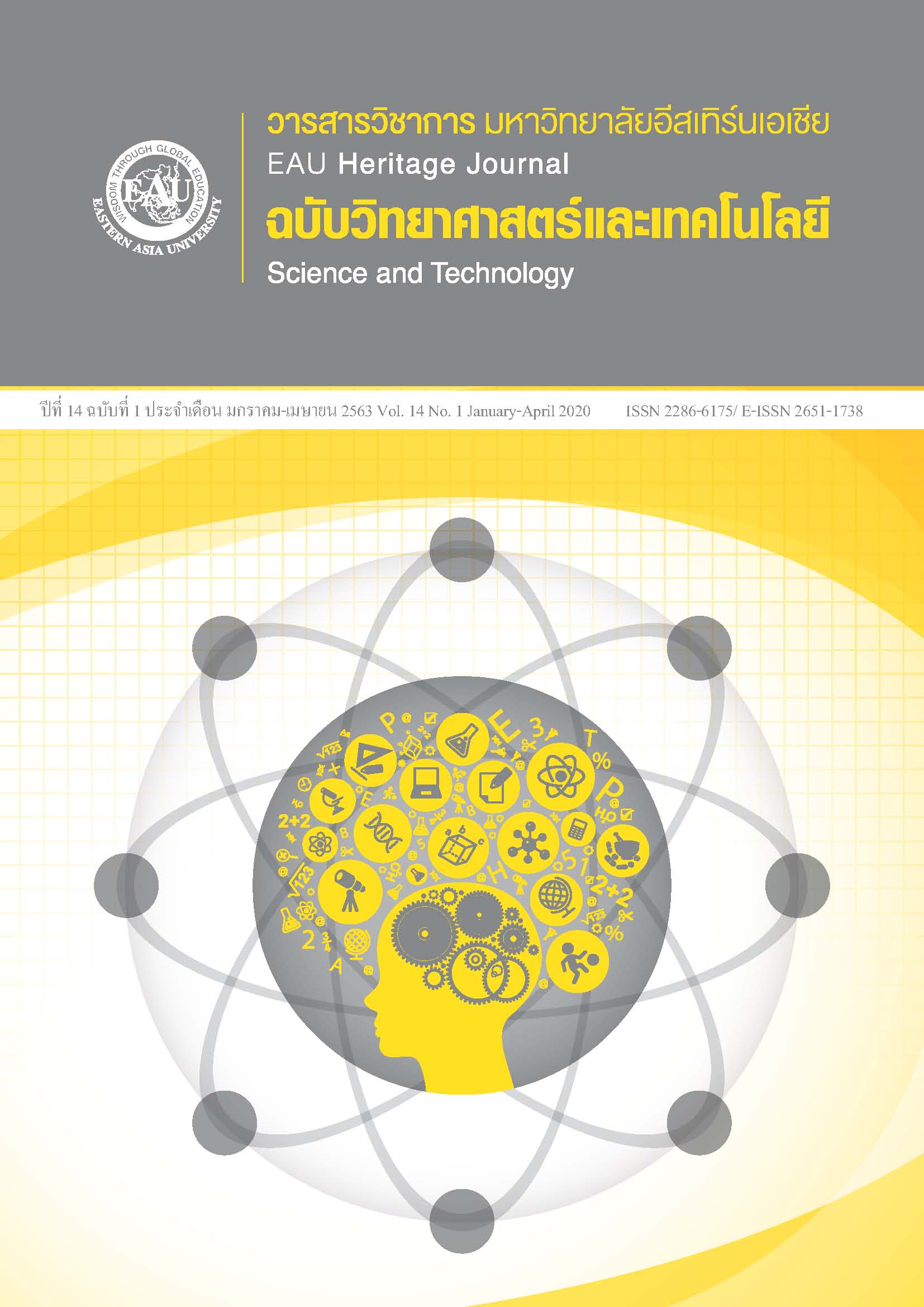พฤติกรรมการใช้สารเคมีทางการเกษตรและระดับเอ็นไซม์โคลีนเอสเตอเรส ในเลือดของเกษตรกร อำเภอบ้านหมี่ จังหวัดลพบุรี ประเทศไทย
คำสำคัญ:
พฤติกรรมการใช้สารเคมี, ความรู้, ทัศนคติ, ระดับเอ็นไซม์โคลีนเอสเตอเรสบทคัดย่อ
การวิจัยครั้งนี้ เป็นการวิจัยแบบผสมผสาน (Mixed Method) มีวัตถุประสงค์เพื่อ (1) ศึกษาพฤติกรรมการใช้สารเคมีทางการเกษตรของกลุ่มเกษตรกรและระดับเอ็นไซม์โคลีนเอสเตอเรสในเลือดของเกษตรกร (2) ศึกษาปัจจัยที่มีความสัมพันธ์กับพฤติกรรมการใช้สารเคมีทางการเกษตรและระดับเอ็นไซม์โคลีนเอสเตอเรสในเลือดของเกษตรกร กลุ่มตัวอย่าง คือ เกษตรกรที่มีผลเลือดเสี่ยงหรือไม่ปลอดภัย จำนวน 84 คน เก็บข้อมูลโดยการตอบแบบสอบถาม สัมภาษณ์เชิงลึกและการสนทนากลุ่ม ระหว่างวันที่ 1-30 กันยายน 2560 วิเคราะห์ข้อมูลโดยใช้ ความถี่ ร้อยละ ค่าเฉลี่ย ส่วนเบี่ยงเบนมาตรฐาน การวิเคราะห์ไคสแควร์ สัมประสิทธิ์สหสัมพันธ์ของเพียร์สัน การทำนายอิทธิพลด้วยสถิติถดถอยพหุคูณ และการวิเคราะห์ข้อมูลเชิงเนื้อหา ผลการวิจัยพบว่าเกษตรกรมีพฤติกรรมการใช้สารเคมีทางการเกษตรที่มีผลต่อระดับเอ็นไซม์โคลีนเอสเตอเรสในเลือด ร้อยละ 63.1 มีพฤติกรรมถูกต้อง สม่ำเสมอ ร้อยละ 31.0 มีพฤติกรรมถูกต้องไม่สม่ำเสมอ ร้อยละ 6.0 มีพฤติกรรมไม่ถูกต้อง ปัจจัยที่มีความสัมพันธ์กับพฤติกรรมการใช้สารเคมีทางการเกษตรของเกษตรกรและระดับเอ็นไซม์โคลีนเอสเตอเรสในเลือดของเกษตรกรอย่างมีนัยสำคัญทางสถิติ (P-value<.05) ได้แก่ ประเภทการทำการเกษตร รายได้ต่อเดือน จำนวนวันที่ใช้สารเคมี ความรู้เกี่ยวกับการใช้สารเคมีทางการเกษตร ทัศนคติต่อการใช้สารเคมีทางการเกษตร และปัจจัยที่มีอิทธิพลและสามารถคาดทำนายพฤติกรรมการใช้สารเคมีทางการเกษตรของเกษตรกรและระดับเอ็นไซม์โคลีนเอสเตอเรสในเลือดของเกษตรกร อย่างมีนัยสำคัญทางสถิติ (p-value<.05) ได้แก่ รายได้ต่อเดือน ประเภทการทำการเกษตร และสถานภาพสมรส สามารถคาดทำนายได้ ร้อยละ 20 ผลการศึกษานี้เสนอแนะให้สาธารณสุขอำเภอ ดำเนินการประชาสัมพันธ์พฤติกรรมการใช้สารเคมีอย่างปลอดภัยและการปรับทัศนคติต่อการใช้สารเคมีของเกษตรกร
เอกสารอ้างอิง
References
Banmi District Public Health Office. (2015). Report on the operation of the surveillance of occupational diseases. The profession of a sub-district hospital in Banmi District Lopburi Province, 2015 (Research report). Lopburi: Banmi District Public Health Office. (in Thai)
Banmi District Public Health Office. (2016). Report on the operation of the surveillance of occupational diseases. The profession of a sub-district hospital in Banmi District Lopburi Province, 2016 (Research report). Lopburi: Banmi District Public Health Office. (in Thai)
Bloom, S. J., & Benjamin, S. J. (1975). Taxonomy of education objective, hand book 1: Cognitive domain (1st ed). New York: David Mckay.
Dana, C. (2014). Behaviors of using chemical pesticides among sugarcane farmers. Master of Nursing Thesis Community Practice Nursing. Graduate School, Khon Kaen University. (in Thai)
Kudting, W., & Kanato, M., (2015) Factors affecting the knowledge, behaviors and health impacts of pesticide users in the area responsible for health promotion hospitals, Suksaran Sub-District Na Dan Subdistrict Suwannakhuha District Nong Bua Lamphu Province. Journal of Community Health Development Khon Kaen University, 3(1), 133-146. (in Thai)
Nuthong, V. (2013). The pesticide use behavior of agriculturists at the Sai-noi Subdistrict Sai-noi District Nonthaburi Province. Master of Social Sciences Thesis, (Environment). Mahidol University. (in Thai)
Office of Epidemiology The Department of Disease Control, Ministry of Public Health. (2016). Report a patient who received a chemical toxin removal pesticides (pesticide poisoning), disease surveillance data, Nonthaburi (Research report). Nonthaburi: The Department of Disease Control, Ministry of Public Health. (in Thai)
Office of Occupational Diseases and the Environment. the Department of Disease Control, Ministry of Public Health. (2016). The report from the toxic pesticides (Pesticide poisoning). And Risk behavior of farmers from pe. Patients who received sticides (NMG 1-56). Occupational Health Services Administration Guide for public health officials to update (Research report). Nonthaburi: The Department of Disease Control, Ministry of Public Health. (in Thai)
Seabsimma, J., Silawan, T., & Kansakal, N. (2017). The pesticides use and personal protective behavior, pesticide poisoning among chilli farm sprayers in Suan kluai SubDistrict Kantharalak District Sisaket Province. Thai Toxicology Journal 2017, 32(1), 9-25. (in Thai)
Simla, W., & Boonrod, T. (2012). Factors related to pesticide prevention behavior of farmers in Laem Tanot Sub-district Khuan Khanun District Phatthalung Province. Journal of Public Health, 42(2), 103-113. (in Thai)
Siriphanit, S. (2015). The situation and the health effects from the use of chemical pesticides protection 2013. Epidemiological surveillance reports, weekly, 2013, 44(44), 689-692. (in Thai)
Wilaiwan, N. (2016). Factors related to the use of harmful pesticides in pathumthani farmers group. Muang District, Pathumthani Province. 3 rd national academic conference and research presentation step into the decade 2. Integration of research Use knowledge to sustainability “17 June 2016 at Nakhon Ratchasima College, Muang District, Nakhon Ratchasima Province (p. 399). Nakhon Ratchasima: Nakhon Ratchasima College. (in Thai)
Wilson, B. W. (1999). Cholinesterases. In W. F., Loeb & F. W., Quimby: The clinical chemistry of laboratory animals (1st ed.). Philadelphia: Taylor & Francis.
Wilson, B. W. (2001). Cholinesterases. In R. I., Krieger, J., Doull, D., Ecobichon, D., Gammon, E., Hodgson, L., Reiter & J., Ross: Handbook of pesticide toxicology (2nd ed.). San Diego,California: Academic Press.
Wongsakoonkan, W. (2016). Pesticide usage behavior and cholinesterase blood Level of Farmers: Case study of Latlumkaeo District Pathumthani Province. Ratchaphruek Journal, 16(1), 55-64. (in Thai)







